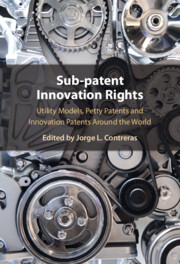Patents are important tools for innovation policy. They incentivize creation and dissemination of new technical solutions and help to disclose their working to the public in exchange for limited exclusivity. But in addition to patents, more than one hundred countries around the world offer a “lesser” form of protection for innovations known variously as utility models, technical designs, petty patents, innovation patents, short-term patents, which this volume refers to collectively as “utility models.”
Utility models have been contemplated alongside patents by the Paris Convention for the Protection of Industrial Property since 1911. Yet neither the Paris Convention nor any other major international agreement explicitly delineates the scope of utility model protection, which is left largely to the discretion of national and regional jurisdictions. The result of this lack of formal treaty guidance is a diverse set of utility model rules that lack significant harmonization across countries and regions and which have ebbed and flowed over time.
Despite their long history and widespread adoption, utility models remain, as Professor Mark Janis observed more than two decades ago, “a backwater of intellectual property.” Compared to the large body of scholarly literature in other areas of intellectual property law, there is scant literature concerning utility models, and only a handful of empirical studies that focus on them.
This volume represents the first book-length study of utility models and other forms of sub-patent innovation protection around the world. It compares, contrasts, and critically analyzes these forms of protection in a range of jurisdictions while shedding light on the manner in which utility models are utilized by innovators and industry.
The international collaboration of scholars and legal practitioners that resulted in this volume began in February 2022. It involved several online workshops during the summer and fall of 2022, as well as a workshop hosted by the London School of Economics and Political Science in February 2023. Preliminary results of this collaboration were presented at the European Policy for Intellectual Property (EPIP) conference held Krakow, Poland, in October 2023, as well as other conferences and symposia around the world.
Several chapters of this volume include empirical analyses of filing, assignment, and litigation data available from national patent offices, the World Intellectual Property Organization (WIPO), and IPLytics, a private patent analytics firm with which we have collaborated. Other chapters present statutory and regulatory analysis of local filing rules, case histories, and the experience of practitioners in this area. On the basis of these comparisons, we present conclusions, or at least offer hypotheses, regarding the relative effectiveness of utility model systems in achieving their purported goals, and the degree to which such systems can or should be harmonized to a greater degree.
We hope that this volume will become a definitive resource for intellectual property attorneys, patent offices, regulators, policymakers, academics, and judges who are confronted with these enigmatic and ever-changing forms of legal protection.
We are grateful to Matt Galway, Jadyn Fauconier-Herry, Balamuthukumaran Pasupathy, and the rest of the production and editorial staff at Cambridge University Press for helping bring this volume to fruition.

